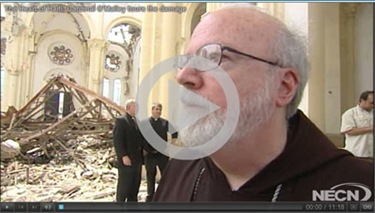Dear Readers,
On Thursday, I had a visit with Sister Agatha Osarenkkoe, the newly elected superior general of the Sisters of the Eucharistic Heart of Jesus, Sister Christiana Onyewache, and our Delegate for Religious, Sister Marian Batho.
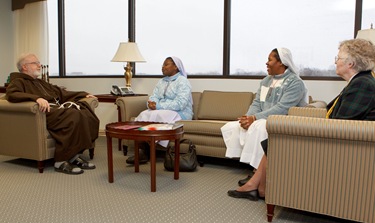
We are grateful for the work that Sister Christiana is doing in the archdiocese with the Nigerian community here.
– – –
In the evening we were visited by Dr. Andy Gomez of the University of Miami.
![clip_image001[4] clip_image001[4]](https://cardinalseansblog.org/wp-content/uploads/2010/03/clip_image0014.jpg)
Dr. Gomez gave us some updates on the situation in Cuba after the death of Orlando Zapata Tamayo who was on hunger strike for 85 days.
During the visit he presented me with a jar of Cuban soil that came from the site of his father’s grave.

I was touched by that gesture. There are so many Cubans who have not gone back since the time of the revolution. Many are forbidden from traveling to Cuba, others refuse to go back on principle.
It reminded me of when, as a young lad, I went to Ireland and my grandfather said, “Bring a little dirt back on your shoe.” People have that attachment to their homeland.
– – –
On Saturday, we had the 5th annual Boston Catholic Women’s Conference at the Cathedral.

Having the event at the Cathedral was a great blessing. There was a great deal of enthusiasm expressed for the experience the women had at the mother church of the Archdiocese of Boston.


The event was possible thanks to the generosity of Father Kevin O’Leary, the Cathedral’s rector, as well as Christol Murch and everyone at Cathedral High, which allowed many of its facilities to be used.


The speakers were all very well received. I was pleased to be able to celebrate the closing Eucharist.





– – –
Later in the day, we had a whirlwind visit by Kiko Arguello, the initiator of the Neocatechumenal Way. He was supposed to visit during the day but his plane coming from D.C. was cancelled, so he was in Boston just for a couple of hours.

We discussed the addition of a new vice-rector for our Redemptoris Mater Seminary, the plans for building a center for the Church in Jerusalem and the upcoming meeting of American bishops with the Neocatechumenal Way that will take place at the Domus Galilaeae in Israel next January.

It was a joy to have him in Boston. I am always in awe of his energy, enthusiasm, and optimism.
– – –
The next morning, I went to St. Mary’s in Chelmsford for a family Mass. The church was filled with young families. It was a great celebration. They have a wonderful children’s choir.
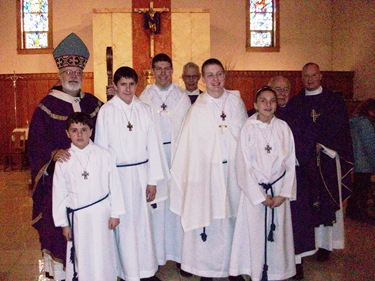
Altar servers with Fr. Stephen Donohoe, Pastor (far right),
Deacon Jack Bortz (inside right, next to Fr. Steve),
Parochial Vicar Fr. William Dunn (center)
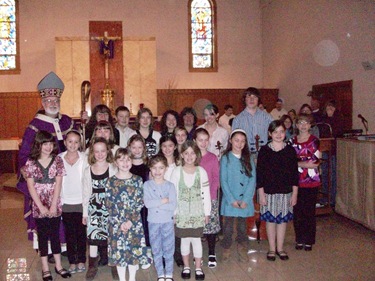
Parish Children’s Choir
We enjoyed being there very much with Father Steve, who has done a wonderful job.
– – –
On Monday morning, before flying to Haiti, I was able to visit the Agrupación Católica in Miami and to see my old friends Father Amando Llorente and Javier Suarez.
Father Llorente has been the director of the Agrupacion since 1952 when he first arrived in the United States.
![clip_image001[6] clip_image001[6]](https://cardinalseansblog.org/wp-content/uploads/2010/03/clip_image0016.jpg)
I celebrated Mass with Father Amando and Javier, and afterwards I was able to get a quick tour of some of the new features of the retreat center.
Below you see a new monument for the Jesuit Martyrs of Florida. They call this the “Plaza de la Evangelizacion,” the Plaza of Evangelization. It’s in a beautiful location overlooking the water on the shore of Miami.
![clip_image002[4] clip_image002[4]](https://cardinalseansblog.org/wp-content/uploads/2010/03/clip_image0024.jpg)
![clip_image003[4] clip_image003[4]](https://cardinalseansblog.org/wp-content/uploads/2010/03/clip_image0034.jpg)
From there we went back to the airport to meet up with the delegation from the USCCB and fly to Port-au-Prince.
– – –
I was asked by the Bishops Conference to be a part of a committee to assess the needs of the Church in Haiti. The committee is working out of the secretariat for Latin America. This year, our chairman is Archbishop Gomez, and the committee consists of Archbishop Gomez, Bishop Sansaricq, the auxiliary bishop of Brooklyn who helped me to start the Haitian ministry in Washington, D.C. forty years ago; Bishop Tom Wenski of Orlando who ran the Haitian center in Miami for many years; Father Andrew Small who is director of the office; and myself.
![clip_image004[4] clip_image004[4]](https://cardinalseansblog.org/wp-content/uploads/2010/03/clip_image0044.jpg)
The purpose of our trip was to express the solidarity of our bishops’ conference and begin the conversation about what the ongoing needs are going to be and how we might help contribute and coordinate in the effort of rebuilding Haiti, particularly the Catholic Church’s institutional presence. The Catholic Church is the most important institution in Haiti.
We flew out of Fort Lauderdale and there was a very long delay.
When we got to Haiti, we were met by the nuncio and people from Catholic Relief Services (CRS). Lisa Wangsness, a reporter for the Boston Globe, and R.D. Sahl of NECN were there as well.
The nuncio took us from the airport to the nunciature, where we had dinner with President René Préval and his wife Elisabeth.
It was very interesting to meet with them. We were grateful he and his wife made time for our delegation to share with us some of their hopes and concerns for Haiti.
I gave rosaries to him and his wife, and he gave me books on the history of the city of Port-au-Prince from 1743 to 1950.
![clip_image005[4] clip_image005[4]](https://cardinalseansblog.org/wp-content/uploads/2010/03/clip_image0054.jpg)
The author is a Haitian historian, George Corvington. I looked at the section that he has on the Catholic Church. It’s very interesting and it has a number of historic pictures.
![clip_image006[4] clip_image006[4]](https://cardinalseansblog.org/wp-content/uploads/2010/03/clip_image0064.jpg)
These pictures document a very different Haiti from the Port-au-Prince that we were experiencing after the earthquake, which is possibly the greatest natural disaster of our lifetime.
![clip_image007[4] clip_image007[4]](https://cardinalseansblog.org/wp-content/uploads/2010/03/clip_image0074.jpg)
![clip_image008[4] clip_image008[4]](https://cardinalseansblog.org/wp-content/uploads/2010/03/clip_image0084.jpg)
![clip_image009[4] clip_image009[4]](https://cardinalseansblog.org/wp-content/uploads/2010/03/clip_image0094.jpg)
The cathedral
More people perished in the earthquake in Port-au-Prince than at Hiroshima. This devastation is compounded by the fact that the resources in Haiti are so limited and Haiti, as a country, is unable to deal with it.
The international community is coming together to help, but there is going to be great challenges in coordinating both the relief efforts and reconstruction going forward. Certainly, there’s been a great outpouring of concern and it was encouraging to see the doctors and others who have gone there. I know that our American troops are also making a big difference in terms of safety and distributing relief.
At the dinner, the president’s wife gave us a picture drawn by children. She’s very much involved in the efforts in education.
![clip_image010[4] clip_image010[4]](https://cardinalseansblog.org/wp-content/uploads/2010/03/clip_image0104.jpg)
![clip_image011[4] clip_image011[4]](https://cardinalseansblog.org/wp-content/uploads/2010/03/clip_image0114.jpg)
Education is certainly one of the priorities that the bishops want to promote going forward. Before the earthquake, only half of the children in Haiti went to school. The other half did not. Only 10 percent of the schools are public schools. The rest of the schools are private, many of them Catholic schools. For the Church, that ministry is a very important one.
Tuesday morning we had Mass for Les Fille de Marie at their general house. They lost 14 of their sisters in a convent that collapsed, and 11 of their sisters who were very seriously injured were taken to Santo Domingo where some of them are having amputations and other kinds of surgery.
![clip_image012[4] clip_image012[4]](https://cardinalseansblog.org/wp-content/uploads/2010/03/clip_image0124.jpg)
It was a very moving experience to hear what the sisters had been through.
![clip_image013[4] clip_image013[4]](https://cardinalseansblog.org/wp-content/uploads/2010/03/clip_image0134.jpg)
![clip_image014[4] clip_image014[4]](https://cardinalseansblog.org/wp-content/uploads/2010/03/clip_image0144.jpg)
Bishop Sansaricq’s sister, who belongs to Les Filles de la Sagesse, the Daughters of Wisdom, lives in a convent right near where we were. So, she came to be at the Mass and see her brother. Sister Sylvia is her name.

From there we went to Louverture Cleary, which is a Catholic school named after both Toussaint Louverture, one of the great revolutionary heroes in Haiti, and Father Cleary who was a priest from Providence and the pastor of St. Joseph Church there.

St. Joseph Parish has been instrumental, along with other parishes, in sponsoring this school. Deacon Patrick Moynihan from Providence and his wife live in Haiti with their children and run the school. They are extraordinary individuals with high energy.

There are a couple hundred students in the school. This is a school for exceptional children taken from the slums.

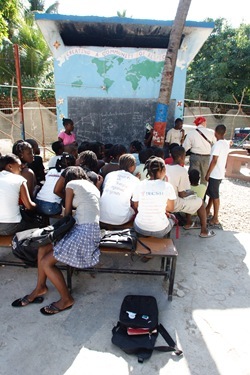
They all learn four languages and are prepared for university work. The children themselves each day spend time teaching other children who don’t go to school how to read and write. They are asked to commit themselves to stay in the country once they become adults, because many of the professional class have left Haiti.

On the other hand, over half of the gross national product of Haiti is comprised of the remittances that Haitians in the United States and Canada send back as direct aid to their families, which provide the possibility for food, education, and shelter – for very basic needs for their families.
Patrick and his wife showed us the facilities.
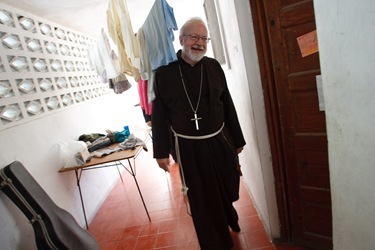
He compares the place to a medieval monastery where the surrounding community is involved because they hire a lot of people who live in the very poor neighborhood there. They are helping them to rebuild their houses. It’s just an extraordinary enterprise.
They have so many different activities and at the center of it all is the school. There are a number of international volunteers, as well as Haitians, on staff there.
It is just one more reminder of how many ties there are with the Church in New England and Haiti.
From there, we went to visit the cathedral.

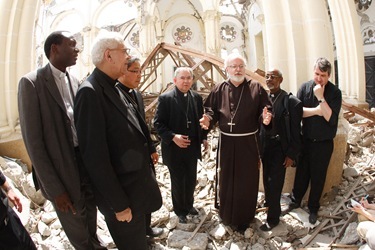
We prayed on the ruins of the cathedral. They showed us where the bishop’s residence had been, but that is completely gone. The offices of Radio Soleil and the other diocesan offices are still standing, but it is like the Leaning Tower of Pisa, you wonder how it is still standing.

Certainly, the symbolism of the destroyed cathedral, the loss of the National Palace and other landmarks are obviously a large psychological blow to the people.
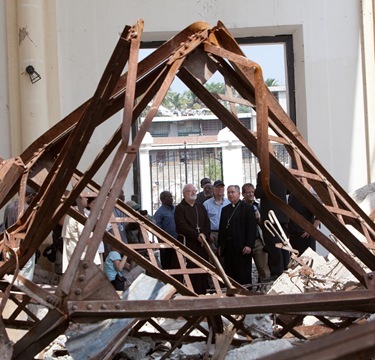
From there, we visited the Saint Françoise de Sales Hospital, which is run by the Archdiocese of Port-au-Prince. There were many volunteers there – some from Maryland and many other places.
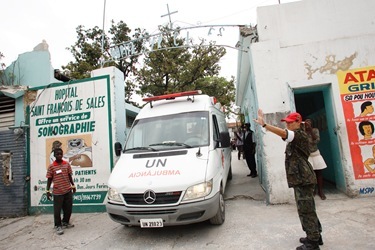
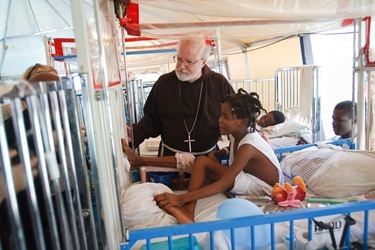
I was very impressed by one Haitian doctor I met there, who after the hurricane, sent his family to Canada, but he stayed in Haiti. He’s living in his car. His house is gone. He spends every day taking care of the children at the hospital.
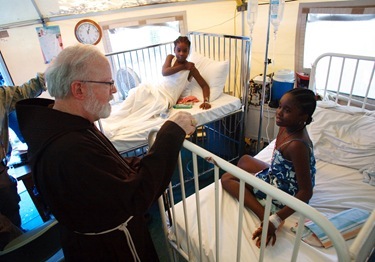
A number of the doctors working there who come in from other countries are living at the nunciature.
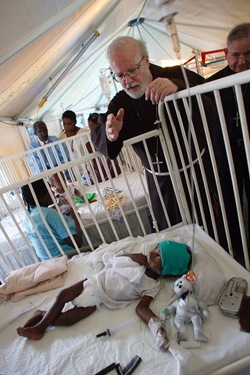
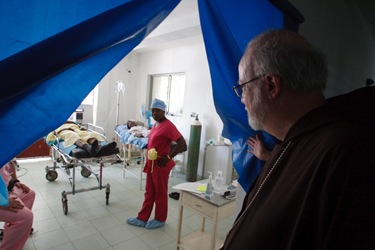
The nunciature is running a something like a hotel for doctors there. We met a wonderful Filipino doctor and his wife, who are both from California. They are all volunteering. The buildings of the hospital are damaged, so they set up tents in the courtyard.
We also visited the grave of Archbishop Miot.
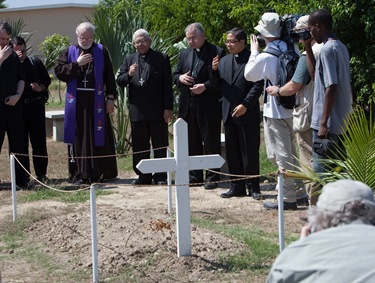
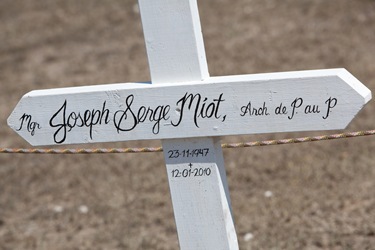
Then we visited the seminary that collapsed, killing a number of seminarians. I think there were 11 or 12 seminarians of the Montfort Fathers who were crushed. They were in a van trying to escape and a building fell on them. There we met a young seminarian, also a Montfort seminarian, who will be coming up to Boston for brain surgery. The Partners in Health have taken him under their wing.
Then we went back to the nunciature. From there we visited the largest refugee camp, which is the Petionville Club Camp. They have taken over an old country club, and Catholic Relief Services is running that camp.
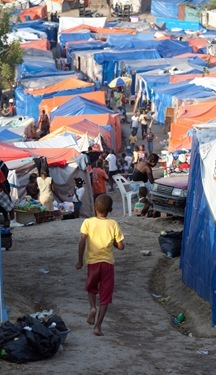
It is very well run and American troops are helping to maintain security and guard it. There are about 60,000 people sleeping there every night, and they have food, medical services and many other activities for the people. They have organized a camp government, a council of people within the camp to help plan and make decisions for that community. It is like a large town. Everyone there has the highest praise for what Catholic Relief Services is accomplishing there and throughout Haiti.
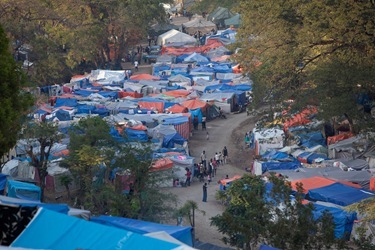
From there, we visited the convent of a very small community of cloistered Carmelite sisters.
There were three Haitian sisters and one French sister. They had taken in a lot of children whose families could not take care of them. Everywhere you go people had tents because they’re afraid to stay inside.
When we got there, there were three tents. Someone said, paraphrasing the Gospel, “How good it is for us to be there and let us build three tents.” There were three nuns in that monastery and three tents.
I told them we have two cloistered Carmelite convents in Boston, and I would take their greetings back to them.
In the camps, the religious spirit of the people was quite noticeable. They would sing religious hymns for hours every night. There were priests and others ministering to their pastoral needs. In fact, one of the things we brought with us were vestments to give them because some of the priests didn’t even have vestments for the celebration of the Eucharist.
From there, we went back to the nunciature where we had dinner with a number of leaders of the community. Among them were Dr. Edmond Mulet, who is the new head of the UN delegation there.
Of course even before the earthquake, the UN had a very large presence in Haiti. They were working in many different areas to try and help the country before but they lost 91 of their people. Dr. Mulet was sent to begin rebuilding their presence in the country.
It was quite interesting to listen to some of his thoughts and concerns and I was pleased to learn we have some mutual friends in Guatemala, Victor Menendez and Alvaro Arzú and others.
After this meal with the various leaders in the community, we had a long meeting late into the night with the bishops and the nuncio to discuss the next steps and how to coordinate the efforts of the Church.
The following day, Father Small was going to Germany to meet with different Catholic organizations there.
So much needs to be done with the rebuilding of the communities. Part of the question is: Where will those communities be and will people be able to move back to the same neighborhoods? There’s still concern from geologists and others that there could be more seismic activity. One of the faults, we are told, goes right underneath the nunciature. (They have their little tents on the lawn there too.)
I was so impressed with the nuncio, Archbishop Bernardito Cleopas Auza, who is Filipino.
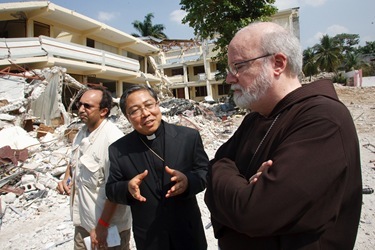
Touring the damage with Archbishop Bernardito Auza
I was so impressed by his ability to deal with the situation. He had been stationed at the Holy See’s delegation to the United Nations in New York as well as Geneva, so he has an understanding of these international organizations, and he speaks perfect English which is helpful in dealing with U.S. organizations, especially the military. I think he is a great support to the bishops of Haiti.
At this time, it’s very challenging not having an archbishop, but the administrator is Bishop Joseph Lafontant, the auxiliary bishop. He has been auxiliary bishop for many years in Port-au-Prince, and is doing an admirable job guiding that diocese through the worst point in its history.
Over half a million refugees have gone to the other provinces of Haiti. In a way, that’s a blessing, but those provinces are ill-equipped to receive them. They don’t have food and resources for the people that are there. One of the things that CRS is doing is paying for the tuition and food of those children who are in Catholic schools when they go to those other parts of the country.
They want to give people incentives to stay in those other towns so people don’t go back to Port-au-Prince. Port-au-Prince is a disaster area. There’s no water, electricity, or basic services. People are better off being out there. As I said, only 10 percent of the schools are public schools. The Catholic school system is much bigger. Many of the Catholic schools are free but others need to charge. So, CRS will help to underwrite the education of the children that are refugees in the various provinces.
The next morning, we had Mass at the Missionaries of Charity. The Missionaries of Charity have about 65 sisters working in Haiti. We were very happy to be able to meet with them and hear about their work. I was delighted that the sister who founded my community in St. Thomas in the Virgin Islands is now there – Sister Genova.
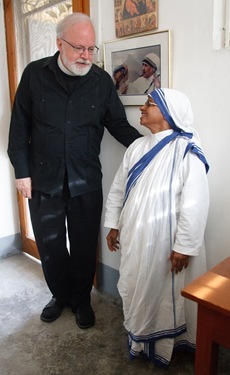
I asked Archbishop Gomez to preside at that Mass. We all concelebrated the Mass with the sisters.
Everywhere we went, we were very warmly received. People were comforted to realize the Church in the United States is very concerned about them. They were grateful for the help they are receiving. We were all very edified by the faith, resilience, and the spirit and determination of the Haitian people in the face of such tragedy. The Haitian people have such great faith. They’ve suffered much in their history, yet the spirit that motivates them is their love for God and trust in His providence. Everyone talked about how, in the refugee camps, you’d hear people singing hymns all night long.
The following two videos will help you get a good sense of the destruction and the wonderful work of the Church and so many volunteers in Haiti:
Please continue to pray for the victims of the earthquake and their families.
Much love and peace.
Cardinal Seán

